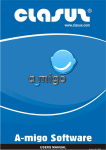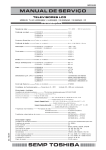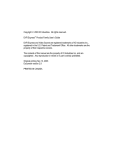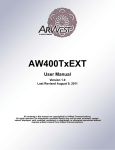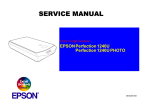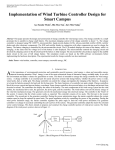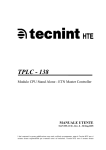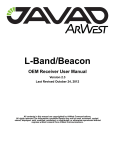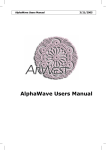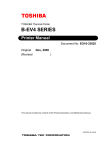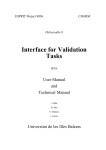Download UP 3 Hardware Reference Manual
Transcript
UP3 Education Kit Reference Manual,Cyclone Edition Version 01 August 2004 System Level Solutions Inc. (USA) 14702 White Cloud Ct. Morgan Hill, CA 95037 System Level Solutions (India) Pvt. Ltd 9/B Radhakrishna Colony, Mangalpura Road, Anand - 388001. UP3 Education Kit 2 System Level Solutions UP3 Education Kit Copyright©2004 System Level Solutions, Inc. (SLS) All rights reserved. SLS, an Embedded systems company, the stylized SLS logo, specific device designations, and all other words and logos that are identified as trademarks and/or service marks are, unless noted otherwise, the trademarks and service marks of SLS in India and other countries. All other products or service names are the property of their respective holders. SLS products are protected under numerous U.S. and foreign patents and pending applications, mask working rights, and copyrights. SLS reserves the right to make changes to any products and services at any time without notice. SLS assumes no responsibility or liability arising out of the application or use of any information, products, or service described herein except as expressly agreed to in writing by SLS. SLS customers are advised to obtain the latest version of specifications before relying on any published information and before orders for products or services. System Level Solutions 3 UP3 Education Kit About this manual How to find the information About this manual This is the first publication of the reference manual of the UP3 (University Program 3) Education Kit published in August, 2004. • • • 4 The Adobe Acrobat Find feature allows you to search the contents of a PDF file. Use Ctrl + F to open the Find dialog box. Use Ctrl + N to open to the Go To Page dialog box. Thumbnail icons, which provide miniature preview of each page, provide a link to the pages. Links allow you to jump to related information. System Level Solutions How to contact SLS How to contact SLS UP3 Education Kit For the most up-to-date information about SLS products, go to the SLS worldwide website at http://www.slscorp.com. TABLE 1. Contact Information System Level Solutions Information Type India & USA Product literature services, SLS literature services, Non-technical customer services. http://www.slscorp.com Technical support. [email protected] 5 UP3 Education Kit 6 System Level Solutions UP3 Education Kit CONTENTS ABOUT THIS MANUAL ...............................................................................4 How to find the information ........................................................................4 How to contact SLS ...................................................................................5 Features ...................................................................................................9 General Description.................................................................................10 COMPONENTS .........................................................................................11 Board Diagram ........................................................................................11 UP3 Education Kit ...................................................................................12 The Cyclone EP1C6Q240 Device ..........................................................13 Serial Configuration Device ....................................................................15 Active Serial & JTAG............................................................................15 Flash Memory Device ..............................................................................17 SRAM Device ..........................................................................................20 SDRAM Device .......................................................................................22 Liquid Crystal Display ..............................................................................25 LCD Initialization .................................................................................28 Initializing by instruction...................................................................28 Expansion Prototype connector .............................................................32 IDE .......................................................................................................... 38 Serial Port Connector .......................................................................39 I2C Bus ....................................................................................................41 I2C Memory (EEPROM) .....................................................................42 I2C RTC ................................................................................................42 USB ........................................................................................................44 B Type Connector ................................................................................44 PHY-Chip ..............................................................................................44 PS/2 Connector ......................................................................................46 Parallel Port .............................................................................................47 VGA Port .................................................................................................49 Push Button Switches .............................................................................51 Dip Switches ...........................................................................................52 LEDs ........................................................................................................53 Power Supply Circuitry ............................................................................54 Power Supply Configuration Jumper ...................................................54 Clock Circuitry ........................................................................................55 Reset Circuitry ........................................................................................59 System Level Solutions 7 UP3 Education Kit 8 System Level Solutions Features Features UP3 Education Kit The following are some of the features of the UP3 Education Kit. • • • • • • • • • • • • • • • • • • • • System Level Solutions Features an Altera EP1C6Q240 Device and EPCS1 configuration devices Supports intellectual property based(IP-Based) design both with and without a microprocessor USB 1.1 (Full speed & Low speed) RS 232 Port (Full Modem) Parallel port (IEEE1284) PS/2 Port VGA port IDE (Integrated Drive Electronics) 128KBytes of SRAM (64K X 16) 2MBytes of FLASH (1M X 16) 8MByte SDRAM (4M X 16) 2KBytes of I2C PROM (Expandable) Supports multiple clocks like PCI clock, USB clock, IOAPIC clock and CPU clock. JTAG and Active Serial download capability 5V Santa Cruz long Expansion Card Header provides 72 I/O for the development of additional boards providing various funtionalities One user definable 4-bit switch block Four user definable push button switches, and one global reset switch Four user definable LEDs One 16X2 character display LCD Module I2C Real Time Clock 9 UP3 Education Kit General Description 10 General Description The UP3 Education Kit provides a powerful educational support and also a low-cost solution for prototyping and rapidly developing products. The board serves as an excellent means for system prototyping, emulation and hardware as well as software development. The board comes with a powerful Altera Cyclone FPGA. It gives scope to a hardware design engineer to design, prototype and test IP cores or any hardware design using HDLs like Verilog or VHDL. The entire environment helps to quickly implement any processor as well as any real time operating system on the kit. Along with that one can simulate and test ‘C’ or assembly code also. The board has industry standard interconnections, Memory Subsystem, Multiple clocks for system design, JTAG Configuration, expansion headers for greater flexibility and capacity and additional user interface features. The board can be used for DSP applications by interfacing directly to a DSP processor or implementing DSP functions inside the FPGA. In short, it is a dual-purpose kit, which can be used for prototyping and developing VLSI designs as well as designing and developing microprocessor based embedded system designs. System Level Solutions Components UP3 Education Kit Components Board Diagram System Level Solutions Figure 1 shows the top view of the board. FIGURE 1. UP3 Board Top View (not to scale) 11 UP3 Education Kit UP3 Education Kit UP3 Education Kit This section contains a brief overview of the important components on the UP3 Board. Figure 2 shows the snapshot of the same. FIGURE 2. UP3 Board Components 12 System Level Solutions The Cyclone EP1C6Q240 Device The Cyclone EP1C6Q240 Device UP3 Education Kit U11 is an ALTERA Cyclone EP1C6Q240 in a 240-pin in a PQFP. Table 2 lists the Cyclone device features. TABLE 2. Cyclone EP1C6Q240 Device features Logic Elements 5980 RAM Blocks 20 Total RAM Bits 92160 PLLS 2 Maximum User I/Os 185 FPGA uses SRAM cells to store configuration data. Since SRAM memory is volatile configuration data must be downloaded to Cyclone FPGA each time the device powers up. There are three methods to configure the device Active serial configuration, Passive serial configuration, JTAG- based configuration. The UP3 board supports two modes. Active Serial Mode: Active serial configuration is carried out through serial configuration device EPCS1. Serial configuration devices provide a serial interface to access configuration data. During device configuration, Cyclone FPGA read configuration data via the serial interface, decompresses data if necessary, and program their SRAM cells. This scheme is referred to as an AS configuration scheme because the FPGA controls the configuration interface. The Quartus II software automatically generates .pof files that can be downloaded into the configuration device using Byte-Blaster II for Active serial configuration. JTAG Mode: JTAG (Joint Test Action Group) interface. JTAG has developed a specification for boundary-scan testing. This boundary-scan test System Level Solutions 13 UP3 Education Kit The Cyclone EP1C6Q240 Device (BST) architecture offers the capability to efficiently test components on printed circuit boards (PCBs) with tight lead spacing. The BST architecture can test pin connections without using physical test probes and capture functional data while a device is operating normally. The user can also use the JTAG circuitry to shift configuration data into Cyclone FPGA. The Quartus II software automatically generates .sof files that can be downloaded using Byte-Blaster II for JTAG configuration. Cyclone is designed such that JTAG instructions have precedence over any device operating modes. So JTAG configuration can take place without waiting for other configuration to complete (e.g., configuration with serial or enhanced configuration devices). If the user attempt JTAG configuration in Cyclone FPGA during non-JTAG configuration, non- JTAG configuration will be terminated and JTAG configuration will be initiated. Passive configuration mode has not been supported here. This board does not support multiple devices using Active Serial mode. FIGURE 3. EP1C6Q240 Cyclone FPGA EP1C6Q240 14 System Level Solutions Serial Configuration Device Serial Configuration Device UP3 Education Kit U15 is a serial configuration device (EPCS1) for the Cyclone FPGA on UP3 board. Serial configuration devices are flash memory devices with a serial interface that can store configuration data for a Cyclone device and reload the data to the device upon power-up or re-configuration. With the new data-decompression feature in the Cyclone FPGA family, designers can use smaller serial configuration device to configure larger Cyclone FPGA. Active Serial & JTAG: On UP3 board AS configuration scheme is combined with JTAGbased configuration. The MSE (Mode Select Enable) pins are tied low to select the Active Serial Configuration mode. This setup uses two 10-pin download cable headers on the board. The first header (JP11) programs the serial configuration device in-system via the AS programming interface, and the second header (JP12) configures the Cyclone FPGA directly via the JTAG interface. If you try configuring the device using both schemes simultaneously, JTAG configuration takes precedence and AS configuration will be terminated.. TABLE 3. Header JP12 Header JP12 Pin No. System Level Solutions Signal FPGA (U11) Pin No 1 TCK 147 2 GND --- 3 TDO 149 4 +3.3V --- 5 TMS 148 6 +3.3V --- 7 NC --- 8 NC --- 9 TDI 155 10 GND --- 15 UP3 Education Kit Serial Configuration Device TABLE 4. Header JP11 Header (JP11) Pib No. Signal EPCS1 (U15) Pin No. 1 DCLK 6 36 2 GND --- --- 3 CONF_DONE --- 1454 4 +3.3V --- --- 5 CONFIG# --- 25 6 CE# --- 32 FPGA (U11) Pin No. 7 DATA 2 25 8 CSO# 1 24 9 ASDO 5 37 10 GND --- --- FIGURE 4. Active Serial & JTAG Header JTAG Header AS Header 16 System Level Solutions Flash Memory Device Flash Memory Device UP3 Education Kit U8 is a 2Mbyte of Flash memory (TC58FVB160AFT-70) connected to the Cyclone device. The TC58FVT160/B160A is a 16,777,216-bit, 3.0-V read-only electrically erasable and programmable flash memory organized as 2,097,152 words x 8 bits or as 1,048,576 words x 16 bits. The TC58FVT160/B160A features commands for Read, Program and Erase operations to allow easy interfacing with microprocessors. The Program and Erase operations are automatically executed in the chip. Table 5 shows the Flash signal description and its connection with FPGA. FIGURE 5. Flash Memory Devices Flash Memory System Level Solutions 17 UP3 Education Kit Flash Memory Device TABLE 5. Flash Signal Description 18 Flash Pin Signal Name FPGA Pin No. Descritpion 1 A15 76 Address Line 2 A14 75 Address Line 3 A13 75 Address Line 4 A12 68 Address Line 5 A11 67 Address Line 6 A10 66 Address Line 7 A9 65 Address Line 8 A8 64 Address Line 9 A19 78 Address Line 10 NC --- Not Connected 11 WE# 79 Write Enable Signal 12 RESET ---- System Reset 13 NC ---- Not Connected 14 NC ---- Not Connected 15 RY/BY# 80 Ready/Busy Signal 16 A18 81 Address Line 17 A17 82 Address Line 18 A7 63 Address Line 19 A6 83 Address Line 20 A5 84 Address Line 21 A4 85 Address Line 22 A3 86 Address Line 23 A2 87 Address Line 24 A1 88 Address Line 25 A0 93 Address Line 26 CE# 117 Chip Enable Signal 27 VSS --- GND 28 OE# 118 O/P Enable Signal 29 DQ0 94 Data Line 30 DQ8 95 Data Line System Level Solutions Flash Memory Device UP3 Education Kit TABLE 5. Flash Signal Description System Level Solutions Flash Pin Signal Name FPGA Pin No. Descritpion 31 DQ1 96 Data Line 32 DQ9 97 Data Line 33 DQ2 98 Data Line 34 DQ10 99 Data Line 35 DQ3 100 Data Line 36 DQ11 101 Data Line 37 VDD --- Data Line 38 DQ4 102 Data Line 39 DQ12 103 Data Line 40 DQ5 104 Data Line 41 DQ13 105 Data Line 42 DQ6 106 Data Line 43 DQ14 107 Data Line 44 DQ7 113 Data Line 45 DQ15/A-1 114 Data Line / Address Line 46 VSS --- GND 47 BYTE 115 Word / Byte 48 A16 77 Address Line 19 UP3 Education Kit SRAM Device SRAM Device U7 is the 128KBytes asynchronous SRAM (IS61C6416) device. It is a high speed, 1,048,576-bit static RAM organized as 65,536 words by 16 bits. It is fabricated using the ISSI’s high performance CMOS technology. This highly reliable process coupled with innovative circuit design techniques, yields access times as fast as 10 ns with low power consumption. Table 6 describes signals and pin connections of SRAM.. TABLE 6. Pin Out for SRAM 20 SRAM Pin No. Signal Name FPGA Pin No. Description 1 AD-15 76 Address Line 2 AD-14 75 Address Line 3 AD-13 74 Address Line 4 AD-12 68 Address Line 5 AD-11 67 Address Line 6 CE_n 116 7 DQ-00 94 Data Line 8 DQ-01 96 Data Line 9 DQ-02 98 Data Line 10 DQ-03 100 Data Line 11 VCC --- Supply 12 GND --- GND 13 DQ-04 102 Data Line 14 DQ-05 104 Data Line 15 DQ-06 106 Data Line 16 DQ-07 113 Data Line 17 WE_n 79 Write Enable Input 18 AD-10 66 Address Line 19 AD-09 65 Address Line 20 AD-08 64 Address Line 21 AD-07 63 Address Line 22 NC --- Not Connected 23 NC --- Not Connected 24 AD-06 83 Address Line System Level Solutions SRAM Device UP3 Education Kit TABLE 6. Pin Out for SRAM SRAM Pin No. Signal Name FPGA Pin No. Description 25 AD-05 84 Address Line 26 AD-04 85 Address Line 27 AD-03 86 Address Line 28 NC --- Not Connected 29 DQ-08 95 Data Line 30 DQ-09 97 Data Line 31 DQ-10 99 Data Line 32 DQ-11 101 Data Line 33 VCC --- Supply 34 GND --- GND 35 DQ-12 103 Data Line 36 DQ-13 105 Data Line 37 DQ-14 107 Data Line 38 DQ-15 114 Data Line 39 LB_n 77 Lower Byte Control 40 UB_n 82 Upper Byte Control 41 OE_n 118 Output Enable Input 42 AD-02 87 Address Line 43 AD-01 88 Address Line 44 AD-00 93 Address Line FIGURE 6. SRAM Device Flash Memory SRAM System Level Solutions 21 UP3 Education Kit SDRAM Device SDRAM Device U6 is a 8MByte Synchronous Dynamic RAM (IS42S16400B). It is organized as 1,048,576 bits X 16-bit X 4-bank for improved performance. The synchronous DRAMs achieve high speed data transfer using pipeline architecture. All the input and output signals refer to the rising edge of the clock input. Figure 7 below shows the pin configuration of the SDRAM and the figure 8 shows the SDRAM device. Table 7 gives the pin description for the same. TABLE 7. SDRAM Pin Configuration 22 SDRAM Pin No. Signal Name FPGA Pin No. Description 1 VDD --- Supply 2 DQ-00 94 Data Line 3 VDDQ --- Supply 4 DQ-01 96 Data Line 5 DQ-02 98 Data Line 6 GNDQ - GND 7 DQ-03 100 Data Line 8 DQ-04 102 Data Line 9 VDDQ --- Supply 10 DQ-05 104 Data Line 11 DQ-06 106 Data Line 12 GNDQ --- GND 13 DQ-07 113 Data Line 14 VDD --- Supply 15 LDQM 77 Lower Byte, I/O Mask 16 WE_n 79 Wrtie Enable Input 17 CAS_n 75 Column Address Strobe 18 RAS_n 76 Row Address Strobe 19 CE_n 119 Chip Enable Input 20 BA0 68 Bank Select Address 21 BA1 74 Bank Select Address 22 AD-10 66 Address Line 23 AD-00 93 Address Line 24 AD-01 88 Address Line System Level Solutions SDRAM Device UP3 Education Kit TABLE 7. SDRAM Pin Configuration System Level Solutions SDRAM Pin No. Signal Name FPGA Pin No. Description 25 AD-02 87 Address Line 26 AD-03 86 Address Line 27 VDD --- Supply 28 GND --- GND 29 AD-04 85 Address Line 30 AD-05 84 Address Line 31 AD-06 83 Address Line 32 AD-07 63 Address Line 33 AD-08 64 Address Line 34 AD-09 65 Address Line 35 AD-11 67 Address Line 36 NC --- No Connection 37 CKE 115 Clock Enable 38 CLK 11 SDRAM Clock 39 UDQM 82 Upper Byte, I/O Mask 40 NC --- No Connection 41 GND --- GND 42 DQ-08 95 Data Line 43 VDDQ --- Supply 44 DQ-09 97 Data Line 45 DQ-10 99 Data Line 46 GNDQ --- GND 47 DQ-11 101 Data Line 48 DQ-12 103 Data Line 49 VDDQ --- Supply 50 DQ-13 105 Data Line 51 DQ-14 107 Data Line 52 GNDQ --- GND 53 DQ-15 114 Data Line 54 GND --- GND 23 UP3 Education Kit SDRAM Device FIGURE 7. SDRAM Pin Configuration Note: To use the SDRAM, apply inverted clock from FPGA to the SDRAM for the proper SDRAM operations. FIGURE 8. SDRAM Device SDRAM 24 System Level Solutions Liquid Crystal Display Liquid Crystal Display UP3 Education Kit U1 is a 16X2 character Liquid Crystal Display (GDM1602A). Here 16X2 represents 2 display lines with 16 characters per line. The display contains 2 internal byte wide registers, one for the command and second for characters to be displayed. It also contains user programmed RAM area that can be programmed to generate any desired character that can be formed using a dot matrix. GDM1602A part is 5V operative so as to connect it to the FPGA, voltage level shifting is required and this is performed by bus switches (IDTQS3384). TABLE 8. Liquid Crystal Display Signal Description System Level Solutions LCD Pin No. Signal Name FPGA Pin No. Description 1 VSS --- GND 2 VDO --- +5 V 3 VO --- Contrast Setting 4 RS(Resgister select) 108 All these 5 R/W (Read/ Write 73 All these signals are 6 E(Enable signal) 50 7 DB0 94 and are then con- 8 DB1 96 nected to the FPGA level shifted usingIDTQS3384 9 DB2 98 10 DB3 100 11 DB4 102 12 DB5 104 13 DB6 106 14 DB7 113 15 LED+ --- +5V 16 LED- --- GND 25 UP3 Education Kit Liquid Crystal Display Table 8 gives full description about the signals and pin connection of the LCD.The SRAM devices share address lines with the FLASH memory and the data lines are shared with the FLASH and LCD both. FIGURE 9. LCD Liquid Crystal Display 26 System Level Solutions Liquid Crystal Display UP3 Education Kit TABLE 9. LCD Instruction Table CODE System Level Solutions Instruct ion R S R/ W D 7 D 6 D 5 D 4 D 3 D 2 D1 D0 Execute Time (max) Clear Display 0 0 0 0 0 0 0 0 0 1 1.64mS Cursor at Home 0 0 0 0 0 0 0 0 1 - 1.64mS Entry Mode Set 0 0 0 0 0 0 0 1 I/D S 40uS Display On/Off Control 0 0 0 0 0 0 1 D C B 40uS Cursor/ Display Shift 0 0 0 0 0 1 S/ C R/ L - - 40uS function set 0 0 0 0 1 D L N F - - 40uS CGRAM address set 0 0 0 0 DDRAM address set 0 0 1 ADD 40uS Busy Flag/ Address Read 0 1 B F AC 40uS CGRAM / DDRAM Data Write 1 0 Write Data 40uS CGRAM / DDRAM Data Read 1 1 Read Data 40uS ACG 40uS 27 UP3 Education Kit Liquid Crystal Display TABLE 10. LCD Instruction Table SYMBOLS DESCRIPTION SYMBOLS DESCRIPTION I/D = 1 Increment D/L = 0 4 Bit I/D = 0 Decrement N=1 1/16 Duty S=1 With Display Shift N=0 1/8 Duty, 1/11 Duty S/C = 1 Display Shift F=1 5 X 10 dots S/C = 0 Cursor Movement F=0 5 X 7 dots R/L = 1 Shift to the right BF = 1 Internal Operation is being performed R/L = 0 Shift to the left BF = 0 New Instruction D/L = 1 8 Bit acceptable The above execution time is for fosc = 250KHz. However, when frequency changes, execution time also changes. When fosc = 270KHz, then new execution time will be 40uS X (250/270) = 37uS. LCD Initialization: Normally LCD itself executes internal reset operations at power up. But if the power supply condition is not satisfied the internal reset circuit would not operate properly. It is better to provide initialization sequence by instruction. Initializing by instruction POWER ON - 15msec Delay - Function Set - 4.1msec Delay - Function Set - 100microsec - Function Set - 5msec Delay - Function Set Display OFF - Display ON - Entry Mode Set. LCD on UP3 board is of N = 1 (1/16 Duty) and F = 0 (5X7 dots). After this sequence LCD is ready for operation. 28 System Level Solutions Liquid Crystal Display UP3 Education Kit TABLE 11. LCD Instruction Table INSTRUCTION System Level Solutions DESCRIPTION Clear Display Clears all display and returns the cursor to the home position (Address 0). Cursor at Home Returns the cursor to the home position (Address 0). Also returns the display being shifted to the original position. DDRAM contents remain unchanged. Entry Mode Set Sets the cursor move direction and specifies or not to shift the display. These operations are performed during data write and read. Display On / Off Control Sets On/Off of all diaplay(D), cursor On/Off(C), and blink of cursor position character(B). Cursor / Display Shift Moves the cursor and shifts the display without changing DDRAM contents. Function Set Sets interface data length(DL), number of display lines(L) and character font(F). CGRAM Address Set Sets the CGRAM address. CGRAM data is sent and received after this setting. DDRAM Address Set Sets the DDRAM address. DDRAM data is sent and received after this setting. Busy Flag / Address Read Reads Busy flag(FB) indicating internal operation is being performed and reads address counter contents. CGRAM / DDRAM Data Write Writes data into DDRAM or CGRAM CGRAM / DDRAM Data Read Reads data from DDRAM or CGRAM 29 UP3 Education Kit Liquid Crystal Display TABLE 12. Shared Lines on the UP3 board Signal Name 30 FPGA Pin No. SRAM SDRAM FLASH LCD 11 --- SDRAM CLK --- --- 63 AD-07 AD-07 AD-07 --- 64 AD-08 AD-08 AD-08 --- 65 AD-09 AD-09 AD-09 --- 66 AD-10 AD-10 AD-10 --- 67 AD-11 AD-11 AD-11 --- 68 AD-12 BA0 AD-12 --- 74 AD-13 BA1 AD-13 --- 75 AD-14 CAS AD-14 --- 76 AD-15 RAS AD-15 --- 77 LB LDQM AD-16 --- 78 --- --- AD-19 --- 79 WE_n WE_n WE_n --- 80 --- --- RY/BY_n --- 81 --- --- AD-18 --- 82 UB UDQM AD-17 --- 83 AD-06 AD-06 AD-06 --- 84 AD-05 AD-05 AD-05 --- 85 AD-04 AD-04 AD-04 --- 86 AD-03 AD-03 AD-03 --- 87 AD-02 AD-02 AD-02 --- 88 AD-01 AD-01 AD-01 --- 93 AD-00 AD-00 AD-00 --- 94 DQ-00 DQ-00 DQ-00 DQ-00 95 DQ-08 DQ-08 DQ-08 --- 96 DQ-01 DQ-01 DQ-01 DQ-01 97 DQ-09 DQ-09 DQ-09 --- 98 DQ-02 DQ-02 DQ-02 DQ-02 System Level Solutions Liquid Crystal Display UP3 Education Kit TABLE 12. Shared Lines on the UP3 board Signal Name FPGA Pin No. System Level Solutions SRAM SDRAM FLASH LCD 99 DQ-10 DQ-10 DQ-10 --- 100 DQ-03 DQ-03 DQ-03 DQ-03 101 DQ-11 DQ-11 DQ-11 --- 102 DQ-04 DQ-04 DQ-04 DQ-04 103 DQ-12 DQ-12 DQ-12 --- 104 DQ-05 DQ-05 DQ-05 DQ-05 105 DQ-13 DQ-13 DQ-13 --- 106 DQ-06 DQ-06 DQ-06 DQ-06 107 DQ-14 DQ-14 DQ-14 --- 113 DQ-07 DQ-07 DQ-07 DQ-07 114 DQ-15/A-1 DQ-15/A-1 DQ-15/A-1 --- 115 --- CKE BYTE_n --- 116 CE_n --- --- --- 117 - --- CE_n --- 118 OE_n --- OE_n --- 119 - CE_n --- --- 31 UP3 Education Kit Expansion Prototype Connector Expansion Prototype Connector Headers J1, J2, J3 and J4 collectively form the standard-footprint mechanically stable connections that can be used as an interface to a special function daughter card. The expansion prototype connector interface includes 1. 72 pins for prototyping. All 72 I/O pins connect to user I/O pins on the Cyclone device. 2. PCI Clock appears across J4 from master clock chip. 3. User clock appears across J4 from FPGA. 4. An Active LOW Power On Reset signal. 5. Five regulated 3.3V power-supply pins (1A total max load). 6. One regulated 5V power-supply pin. (1A total max load). 7. Numerous ground connections. The output logic level on the expansion prototype connector pins is 5 Volt. There are two form of Santa Cruz headers. Short-header and long-expansion header. In short-header there are J2, J3 & J4 connectors which are 14pins, 40pins and 20pins respectively. Where as long expansion header has additional connector J1 having 40pins. The UP3 Kit Santa Cruz Long header provides 72 I/O pins (5 Volt tolerant) for expansion purposes. Here all 72 I/O lines are buffered and level shifted using bus switches. Figure 10 shows the Santa Cruz connector. 32 System Level Solutions Expansion Prototype Connector UP3 Education Kit FIGURE 10. Santa Cruz Connector J3 Pin1 J2 Pin1 J4 Pin1 J1 Pin1 Figure 11, Figure 12, Figure 13 & Figure 14 show the pin description of the connectors J1, J2, J3 & J4 respectively. System Level Solutions 33 UP3 Education Kit Expansion Prototype Connector FIGURE 11. Expansion Prototype Connector-J1 34 System Level Solutions Expansion Prototype Connector UP3 Education Kit FIGURE 12. Expansion Prototype Connector-J2 System Level Solutions 35 UP3 Education Kit Expansion Prototype Connector FIGURE 13. Expansion Prototype Connector-J3 * should be kept NC for standard Santa Cruz connector 36 System Level Solutions Expansion Prototype Connector UP3 Education Kit FIGURE 14. Expansion Prototype Connector-J4 In the figure 14, • • • System Level Solutions Connector pin 9 indicates clock from board oscillator Connector pin 11 directs the clock from PLD Connector pin 12 refers to the clock output from protocol to PLD 37 UP3 Education Kit IDE IDE J3 on Santa-Cruz connector can be used as IDE interface connector. Floppy Drive, Hard Drive and CD ROM Drive usually connect to the computer through an Integrated Drive Electronics (IDE) interface. Essentially, an IDE interface is a standard way for a storage device to connect to a computer. Table 13 gives the pin connections of IDE. TABLE 13. IDE 38 FPGA Pin No. Signal --- RESET# 1 217 D7 3 Signal FPGA Pin No. 2 GND --- 4 D8 220 IDE Pin No. (S.C. J3) 216 D6 5 6 D9 219 215 D5 7 8 D10 218 206 D4 9 10 D11 221 207 D3 11 12 D12 222 208 D2 13 14 D13 223 213 D1 15 16 D14 224 214 D0 17 18 D15 225 --- GND 19 20 NC --- 199 DMARQ 21 22 GND --- 200 WE# 23 24 GND --- 201 OE# 25 26 GND --- 202 IORDY 27 28 CSEL 196 203 DMACK 29 30 GND 204 INTRQ 31 32 IOCS16 197 205 A0 33 34 PDIAG 179 176 A1 35 36 A2 178 174 CS0# 37 38 CSI 124 173 DASP# 39 40 GND --- System Level Solutions Serial Port Connector Serial Port Connector UP3 Education Kit SER2 is the standard DB-9 Serial connector. It has all 9-pin connections to the FPGA, a FULL Modem interface. This connector is typically used for communication with a host computer using a standard serial cable connected to (for example) a COM port. U21 (MAX 3243) is a level translator for interfacing the SER2, Full Modem serial port, with the FPGA. Figure 15 shows Serial Port connector. Table 14 shows the pin description of the Serial Port connector. FIGURE 15. Serial Port Connector Serial Port Connector System Level Solutions 39 UP3 Education Kit Serial Port Connector TABLE 14. Pin Description for Serial Port 40 FPGA Pin No. DB-9 (SER2) Pin No. Description --- 1 DCD-232 LEVEL 4 RSIN1 --- 2 RX-232 LEVEL 6 RSIN2 --- 3 TX-232 LEVEL 9 RSOUT1 U21 (MAX 3243) Pin No. --- 4 DTR-232 LEVEL 10 RSOUT2 --- 5 GND-232 LEVEL 25 GND --- 6 DSR-232 LEVEL 5 RSIN2 --- 7 RTS-232 LEVEL 11 RSOUT3 --- 8 CTS-232 LEVEL 7 RSIN4 --- 9 RI-232 LEVEL 8 RSIN5 39 --- DCD-TTL LEVEL 19 TTLOUT1 42 --- RX-TTL LEVEL 17 TTLOUT3 47 --- TX-TTL LEVEL 14 TLIN1 46 --- DTR-TTL LEVEL 13 TTLIN2 --- --- GND-TTL LEVEL 25 GND 41 --- DSR-TTL LEVEL 18 TTLOUT2 45 --- RTS-TTL LEVEL 12 TTLIN3 43 --- CTS-TTL LEVEL 16 TLOUT4 44 --- RI-TTL LEVEL 15 TTLOUT5 System Level Solutions I2C Bus I2C Bus UP3 Education Kit I2C is a two-wire, bi-directional serial bus that provides a simple and efficient method of data exchange between devices. It is most suitable for short distance communication between many devices. I2C standard is a true multi-master bus, which includes collision detection, and arbitration that prevents data corruption if two or more masters attempt to control the bus simultaneously. It is the most widely used bus, which allows the connection of many types of ICs that are used in a number of different applications. It provides an interface between microprocessor and peripheral devices without wiring full address, data and control. Two I2C buses have been provided on the UP3 board in which one I2C hooks up with memory (IS24C16 [EEPROM]) and other to RTC (M41T00). Both are 5V operative. These two buses are 1. Fast I2C Bus: 400Kbps, EEPROM is on this bus 2. Normal I2C Bus: 100Kbps, RTC is on this bus TABLE 15. I2C Signal Assignments System Level Solutions Header Pin No. Signal FPGA Pin No. --- A0 --- --- A1 --- --- A3 --- --- GND --- JP18.3 SDA 21 JP18.2 SCL 20 --- WP --- --- VCC --- 41 UP3 Education Kit I2C Bus I2C Memory (EEPROM) U16 is a 16 Kbits serial EEPROM (IS24C16). Headers are also provided for this I2C bus. 1. Address lines A0,A1,A2 are shoted to GND. 2. SDA and SCL lines are pulled high through 5.6K resistors. 3. Write Protect pin is left floating, not to write protect the memory. It can be tied HIGH with 5.6Kohm resistor to write protect the upper half of the memory. I2C RTC U5 is a Real Time Clock chip (M41T00) on I2C bus. The M41T00 TIMEKEEPER RAM is a low power Serial TIMEKEEPER with a builtin 32.768kHz oscillator (external crystal controlled). Eight bytes of the RAM are used for the clock/calendar function and are configured in binary coded decimal (BCD) format. Addresses and data are transferred serially via a two-line bi-directional bus. The built-in address register is incremented automatically after each WRITE or READ data byte. The M41T00 clock has a built-in power sense circuit that detects power failures and automatically switches to the battery supply during power failures. The energy needed to sustain the RAM and clock operations can be supplied from a small lithium coin cell. Typical data retention time is in excess of 5 years with a 50mA/h 3V lithium cell. 1. On UP3 board the RTC is battery backed with 3 V lithium cell. 2. 32.768 KHz crystal is used for the RTC. 3. FT/OUT pin is taken out on the header at JP13.1 for frequency test. 4. Clock, Data and FT/OUT lines are pulled up through 5.6K resistors. 42 System Level Solutions I2C Bus UP3 Education Kit TABLE 16. RTC Pin Configuration U5-RTC Pin No. Header Pin No. Signal FPGA Pin No. 1 --- OSC1 --- 2 --- OSC1 --- 3 --- VBAT --- 4 --- GND --- 5 JP18.4 SDA 121 6 JP18.5 SCL 120 7 JP13.1 FT/OUT --- 8 --- VCC --- Headers for I2C bus (JP18) Signals for both the I2C buses are taken out as headers. These headers can be used to connect another I2C slaves or can be used for debug purpose for existing I2C slaves (RTC and PROM). TABLE 17. Headers for I2C Bus System Level Solutions JP18 Pin No. Signal Description 1 GND 2 SCL - I2C Bus on which RTC is connected 3 SDA - I2C Bus on which RTC is connected 4 SDA - I2C Bus on which PROM is connected 5 SCL - I2C Bus on which PROM is connected 6 VCC +5 Volt 43 UP3 Education Kit USB USB USB is a cable bus that supports data exchange between a host computer and a wide range of simultaneously accessible peripherals. The attached peripherals share USB bandwidth through a hostdetached while the host and other peripherals are in operation. The USB transfers signal and power over a four-wire cable as shown in the figure below. The signaling occurs over two wires on each point-to-point segment. B Type Connector The figure beside shows B-Type connector (J12 on the UP3 board). This connector requires a transceiver (PHY-chip) in order to communicate with FPGA.Table 17 shows pin connections of the B- type connector and Table 18 describes the configuration jumpers. PHY-Chip U22, PHY Chip (1T11A) is the intermediate between FPGA & the two differential lines. It converts the differential line in the three transmit and three receive signals as shown in the figure 16. FIGURE 16. USB PHY Chip interface diagram 44 System Level Solutions USB UP3 Education Kit TABLE 18. Connection table B Type Connector to PHY Chip to FPGA B-Type Connector Pin no. Signal PHY Chip Pin No. --- Signal FPGA Pin No. --- 1 Mode --- --- --- 2 OE 16 --- --- 3 RCV 17 --- --- 4 VP 18 --- --- 5 VM 19 --- --- 6 SUSPEND --- J12.4 GND 7 GND --- J12.1 NC 8 NC --- --- --- 9 SPEED --- J12.2 D- 10 D- --- J12.3 D+ 11 D+ --- --- --- 12 VPO 15 --- --- 13 VMO/FSEO 14 --- --- 14 VCC --- TABLE 19. USB Configuration Jumpers Mode Select System Level Solutions Speed Select Low Speed Full Speed Jumper Mode 0 Mode 1 JP8 Pin 1-2 Pin 2-3 --- --- JP9 --- --- Open Pin 1-2 JP10 --- --- Pin 1-2 Open JP11 --- --- Pin 2-3 Pin 1-2 45 UP3 Education Kit PS/2 Connector PS/2 Connector JP1 is a PS/2 Connector. The PS/2 interface allows the connectivity to a PS/2 device. The connector is a female 6-pin mini din type. FIGURE 17. PS/2 Connector PS/2 Connector TABLE 20. PS/2 Signal Description 46 PS/2 Pin # Signal FPGA Pin No. Descritpion 1 DATA 13 PS/2 Device Data 2&6 NC --- --- 3 GND --- --- 4 +5 V --- PS/2 Device Supply 5 CLK 12 PS/2 Device Clock System Level Solutions Parallel Port Parallel Port System Level Solutions UP3 Education Kit CON1 is a standard DB25 Female parallel port connector. TABLE 21. Parallel Port Signal Description Parallel Port Pin No. Signal FPGA Pin No. 1 C0 8 2 D0 6 3 D1 1 4 D2 5 5 D3 3 6 D4 240 7 D5 238 8 D6 237 9 D7 239 10 S6 236 11 S7 235 12 S5 234 13 S4 233 14 C1 7 15 S3 2 16 +5 V --- 17 C3 4 18 GND --- 19 GND --- 20 GND --- 21 GND --- 22 GND --- 23 GND --- 24 GND --- 25 GND --- 47 UP3 Education Kit Parallel Port FIGURE 18. Parallel Port Connector Parallel Port Connector 48 System Level Solutions VGA Port VGA Port UP3 Education Kit UP3 board has a standard VGA connector. It contains 5 active signals. Two signals compatible with TTL logic levels, horizontal sync and vertical sync, are used for synchronization of the video. Three analog signals with 0.7 to 1.0 volts peak-to-peak levels are used to control the color. The color signals are Red, Green, and Blue. They are often collectively referred as the RGB signals. By changing the analog levels of the three RGB signals all other colors are produced. FIGURE 19. VGA Port VGA Port System Level Solutions 49 UP3 Education Kit VGA Port TABLE 22. VGA Port Pin Configuration VGA Pin No. 50 VGA Interface FPGA Pin No. 1 Red 228 2 Green 122 3 Blue 170 4 NC --- 5 NC --- 6 GND --- 7 GND --- 8 GND --- 9 NC --- 10 GND --- 11 GND --- 12 NC --- 13 H_sync 227 14 V_sync 226 15 NC --- System Level Solutions Push Button Switches Push Button Switches UP3 Education Kit SW4, SW5, SW6 and SW7 are momentary-contact push-button switches and are used to provide stimulus to designs in the Cyclone device. Each switch is connected to the Cyclone general-purpose I/O pin with pull-up resistor. The Cyclone device pin will see logic ‘0’ when each switch is pressed. FIGURE 20. Push Button Swithces Push Button Switches TABLE 23. Push Button Switches Pin Out Table Button SW4 SW5 SW6 SW7 FPGA Pin No. 48 49 57 62 SW8 is a global reset switch connected to the RESET IC (TL775BCP). The RESET IC pin RESETIN# will see logic ‘0’ when pressed. The output of this RESET IC is (RESET# Active LOW) is then connected to the FPGA pin U11.23. The Cyclone device pin will see logic ‘0’ when SW8 is pressed. System Level Solutions 51 UP3 Education Kit Dip Switches Dip Switches SW3 is a block of four switches. Each switch is connected to the Cyclone general-purpose I/O pin with pull-up resistor. The Cyclone device pin will see logic ‘1’ when switch is in ON condition. FIGURE 21. Dip Switches DIP Switches TABLE 24. Dip Switches Pin Out Table Switch FPGA Pin No. 52 SW 3.1 SW 3.2 SW 3.3 SW 3.4 58 59 60 61 System Level Solutions LEDs LEDs UP3 Education Kit D3, D4, D5 and D6 are four individual LEDs connected to the Cyclone device general purpose I/O with current limiting resistors. All of them are active low driven (Common Anode). The LED will glow when there is logic ‘0’ at FPGA pin. TABLE 25. LED Pin Out Table LED D3 D4 D5 D6 FPGA Pin No. 56 55 54 53 FIGURE 22. LEDs LEDs D8 is Configuration Done LED that indicates successful completion of downloading process. The CONFIG_DONE pin (U11.145) of the Cyclone device controls this LED. D15 is INVALID indication LED that indicates faulty/no connection of the serial cable at the serial port (SER2). If invalid voltage appears at any receive lines of the MAX 3243 chip (U21) the LED will glow. U21.21 pin controls this LED. System Level Solutions 53 UP3 Education Kit Power Supply Circuitry Power Supply Circuitry The UP3 board is powered with number of different regulated supply voltages. 1. +1.5 Volt is for Cyclone core supply. 2. +3.3 Volt is for Cyclone I/O ring supply. 3. +5 Volt is for 5volt operative devices on the board. The board accepts +9 Volt unregulated/regulated supply from external source (with center-terminal positive supply). Debug headers provided for the power supply on the board are described in Table 26. TABLE 26. Headers on the board Header Purpose JP6 +5 V regulated supply JP7 +3.3 V regulated supply JP8 Unregulated input voltage to the board JP10 +1.5 V regulated supply Power Supply Configuration Jumper The board is provided with jumper setting for input supply to the board. Jumper pins JP5.2 and JP5.3 are shoted when input supply from external source is +9 volt regulated/unregulated, which is default setting on the board. Jumper pins JP5.1 and JP5.2 are shoted when input supply from external source is +5 volt regulated. The second setting is useful when the 5 Volt regulator chip is not stuffed on the board. 54 System Level Solutions Clock Circuitry Clock Circuitry UP3 Education Kit This development board supports number of IP blocks requiring different frequencies. The UP3 board provides multiple clocks. U18 is a Master clock chip (PI6C106) which provides different clocks on the board. The clock chip uses 14.318MHz crystal (Y1) for its inbuilt oscillator. Table 28 gives pin description of clock chip. JP3 is a 10-pin header for configuring the input clock to the Cyclone device at CLK1 or CLK3 pins. J7 is a 3-pin header for configuring the CPU clock outputs of the clock chip. 1. 2. 3. 4. System Level Solutions PCI clock (33.33MHz) USB clock (48MHz) IOAPIC clock (14.318MHz) and CPU clock (100MHz / 66.66MHz). 55 UP3 Education Kit Clock Circuitry TABLE 27. Clocking Chip Pin Configuration 56 Clock Chip Pin No. Signal Connection 1 GND1 Board ground 2 X1 Crystal Y 1.1 3 X2 Crystal Y 1.2 4 GND2 Board ground 5 PCICLK F Clock setting Jumper JP 3.7 6 PCICLK F NC 7 PCICLK0 Cyclone CLK0 (U 11.28) 8 PCICLK1 NC 9 VDD2 +3.3 Volt Supply 10 PCICLK2 Santa Cruz Connector J4.9 11 PCICLK3 NC 12 PCICLK4 / SEL100/66# CPU clock select jumper J7.2 13 VDD3 +3.3 Volt Supply 14 48 MHz Clock Setting Jumper JP 3.3 15 GND3 Board ground 16 SPREAD# Tied high +3.3 Volt 17 PD# Tied high +3.3 Volt 18 CPU_STOP# Cyclone U 11.123 19 PCI_STOP# Cyclone U 11.122 20 GND Board ground 21 VDDLC +3.3 Volt Supply 22 CPUCLK2 Clock header Jp 4.1 23 CPUCLK1 NC 24 CPUCLK0 Cyclone CLK2 (U 11. 153) 25 VDDLA +3.3 Volt Supply 26 IOAPIC Clock header JP 19.1 27 VDD1 +3.3 Volt Supply 28 REF0 Clock setting Jumper Jp3.6 System Level Solutions Clock Circuitry UP3 Education Kit Table 28 describes jumper setting for CLK1, table 29 describes jumper setting for CLK3 and table 30 is for CPU clock select setting. Table 31 describes details of other clock headers. Table 32 describes the external clock input that can be adjusted by the user. TABLE 28. Jumper Setting for Clock Input to the FPGA at CLK1 CLK1 Jumper Setting FPGA Pin No. USBCLK (U18.14) 48 MHz Shot JP3.4-JP3.3 29 REF0CLK (U18.28) 14.318 MHz Shot JP3.4-JP3.6 29 TABLE 29. Jumper Setting for Clock Input to the FPGA at CLK3 CLK3 Jumper Setting FPGA Pin No. PCICLK_E (U18.5)3.33MHz Shot JP3.8 & JP3.7 152 REF0CLK (U18.28) 4.318 MHz Shot JP3.8 & JP3.6 152 TABLE 30. CPU Clock Select Setting System Level Solutions CPU Clock Jumper Setting FPGA Pin No. 66 MHz Shot JP 7.1 & JP 7.2 153 100 MHz Shot JP 7.2 & JP 7.3 153 57 UP3 Education Kit Clock Circuitry TABLE 31. Other Clock Header Header Signal JP 4.1 CPUCLK2 ( U18.22)(100MHz) as per Jumper Setting JP 19.1 IOAPIC (U 18.26) It is strongly recommended to disable the clocks if not in use, using CPU_STOP and PCI_STOP signals to disable CPU clocks and PCI clocks. TABLE 32. External Clock Input 58 Header Signal FPGA Pin No. JP 2.2 USER CLOCK 38 System Level Solutions Reset Circuitry Reset Circuitry UP3 Education Kit U19 (TL7705BCP) is an integrated-circuit supply-voltage supervisor. The supply-voltage supervisor monitors the supply for under voltage conditions at the SENSE input. During power up, the RESET output becomes active (low) when VCC attains a value approaching 1 V. As VCC approaches 3 V (assuming that SENSE is above VT+), the delay-timer function activates a time delay, after which outputs RESET and RESET goes inactive. When an under voltage condition occurs during normal operation, outputs RESET and RESET goes active. To ensure that a complete reset occurs, the reset outputs remain active for a time delay after the voltage at the SENSE input exceeds the positive-going threshold value. TABLE 33. Reset Signal Assignment System Level Solutions U19 Reset IC Pin No. Signal FPGA Pin No. Connection 1 REF --- --- 2 RESETIN# --- SW8 3 CT --- --- 4 GND --- --- 5 RESET# 23 --- 6 RESET --- NC 7 SENCE +5 V --- --- 8 VCC +5 V --- --- 59




























































